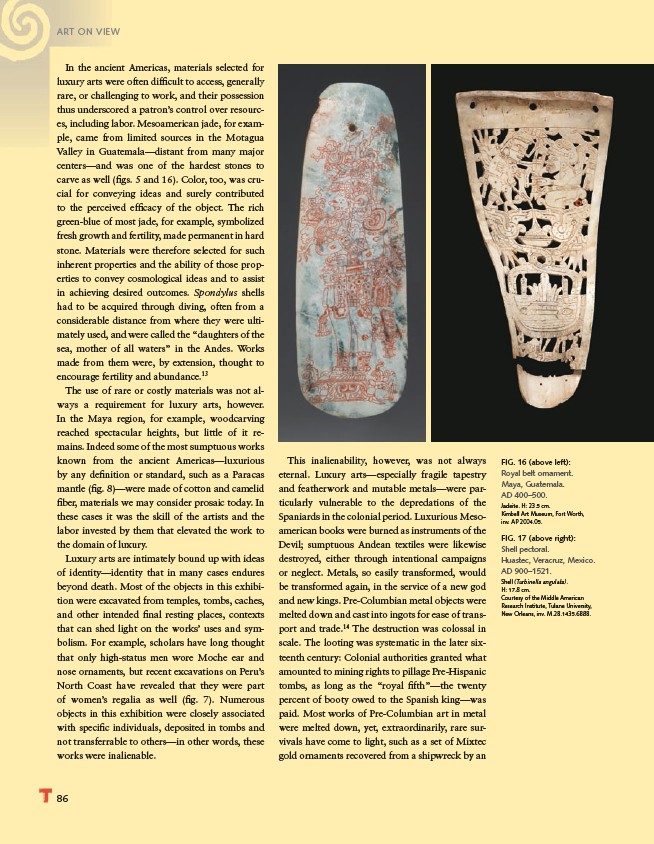
86
FIG. 16 (above left):
Royal belt ornament.
Maya, Guatemala.
AD 400–500.
Jadeite. H: 23.5 cm.
Kimbell Art Museum, Fort Worth,
inv. AP 2004.05.
FIG. 17 (above right):
Shell pectoral.
Huastec, Veracruz, Mexico.
AD 900–1521.
Shell (Turbinella angulata).
H: 17.8 cm.
Courtesy of the Middle American
Research Institute, Tulane University,
New Orleans, inv. M.28.1435.6888.
ART ON VIEW
In the ancient Americas, materials selected for
luxury arts were often diffi cult to access, generally
rare, or challenging to work, and their possession
thus underscored a patron’s control over resources,
including labor. Mesoamerican jade, for example,
came from limited sources in the Motagua
Valley in Guatemala—distant from many major
centers—and was one of the hardest stones to
carve as well (fi gs. 5 and 16). Color, too, was crucial
for conveying ideas and surely contributed
to the perceived effi cacy of the object. The rich
green-blue of most jade, for example, symbolized
fresh growth and fertility, made permanent in hard
stone. Materials were therefore selected for such
inherent properties and the ability of those properties
to convey cosmological ideas and to assist
in achieving desired outcomes. Spondylus shells
had to be acquired through diving, often from a
considerable distance from where they were ultimately
used, and were called the “daughters of the
sea, mother of all waters” in the Andes. Works
made from them were, by extension, thought to
encourage fertility and abundance.13
The use of rare or costly materials was not always
a requirement for luxury arts, however.
In the Maya region, for example, woodcarving
reached spectacular heights, but little of it remains.
Indeed some of the most sumptuous works
known from the ancient Americas—luxurious
by any defi nition or standard, such as a Paracas
mantle (fi g. 8)—were made of cotton and camelid
fi ber, materials we may consider prosaic today. In
these cases it was the skill of the artists and the
labor invested by them that elevated the work to
the domain of luxury.
Luxury arts are intimately bound up with ideas
of identity—identity that in many cases endures
beyond death. Most of the objects in this exhibition
were excavated from temples, tombs, caches,
and other intended fi nal resting places, contexts
that can shed light on the works’ uses and symbolism.
For example, scholars have long thought
that only high-status men wore Moche ear and
nose ornaments, but recent excavations on Peru’s
North Coast have revealed that they were part
of women’s regalia as well (fi g. 7). Numerous
objects in this exhibition were closely associated
with specifi c individuals, deposited in tombs and
not transferrable to others—in other words, these
works were inalienable.
This inalienability, however, was not always
eternal. Luxury arts—especially fragile tapestry
and featherwork and mutable metals—were particularly
vulnerable to the depredations of the
Spaniards in the colonial period. Luxurious Mesoamerican
books were burned as instruments of the
Devil; sumptuous Andean textiles were likewise
destroyed, either through intentional campaigns
or neglect. Metals, so easily transformed, would
be transformed again, in the service of a new god
and new kings. Pre-Columbian metal objects were
melted down and cast into ingots for ease of transport
and trade.14 The destruction was colossal in
scale. The looting was systematic in the later sixteenth
century: Colonial authorities granted what
amounted to mining rights to pillage Pre-Hispanic
tombs, as long as the “royal fi fth”—the twenty
percent of booty owed to the Spanish king—was
paid. Most works of Pre-Columbian art in metal
were melted down, yet, extraordinarily, rare survivals
have come to light, such as a set of Mixtec
gold ornaments recovered from a shipwreck by an